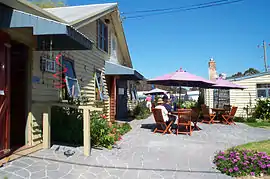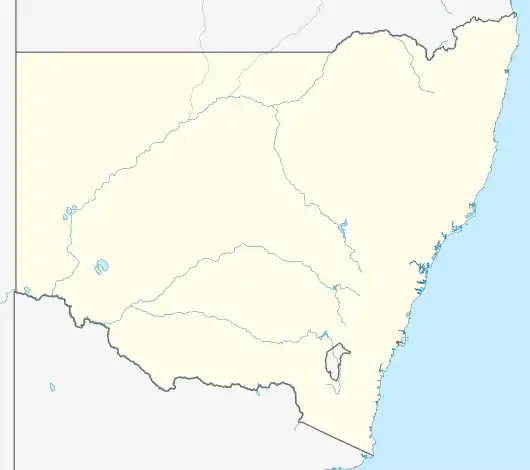| Mogo New South Wales | |||||||||||||||
|---|---|---|---|---|---|---|---|---|---|---|---|---|---|---|---|
 Historic Mogo Village Cafes at Mogo, New South Wales | |||||||||||||||
 Mogo | |||||||||||||||
| Coordinates | 35°47′S 150°08′E / 35.783°S 150.133°E | ||||||||||||||
| Population | 322 (2016 census)[1] | ||||||||||||||
| Established | 1851 | ||||||||||||||
| Postcode(s) | 2536 | ||||||||||||||
| Location | |||||||||||||||
| LGA(s) | Eurobodalla Shire | ||||||||||||||
| State electorate(s) | Bega | ||||||||||||||
| Federal division(s) | Gilmore | ||||||||||||||
| |||||||||||||||
Mogo (postcode: 2536) is a small heritage town in the South Coast region of the state of New South Wales, Australia. Mogo is administered by the Eurobodalla Shire council. The town is located on the Princes Highway (Highway 1), south of Batemans Bay and north of Moruya. At the 2016 census, Mogo had a population of 322.[1]
Mogo was established during the Gold Rush after a gold find was reported in 1851. Bimbimbie, the last gold mine in the Mogo area, closed in 1984. The town survived as a sleepy highway town, and during the 1990s was revitalised with the growth in regional tourism. Mogo is now home to a variety of tourist-centric stores including cafes, art galleries, potters, and furniture stores. Mogo is also a centre for the Aboriginal population of the area.
Mogo is home to Mogo Wildlife Park, a private zoo specializing in breeding programs for endangered species. Although small in comparison to metropolitan zoos, Mogo Wildlife Park is home to many exotic species, such as the red panda and the snow leopard, the latter of which was successfully bred at Mogo Wildlife Park in 1999. Mogo Wildlife Park also participates in programs with other Australian zoos, and its collection of animals changes regularly.
Mogo has a small public primary school, Mogo Public School, that serves Mogo's sparsely populated surroundings. It has around 70 enrolled students, who usually continue their public secondary education at Batemans Bay High School or Moruya High School, or in the private secondary schools of Carroll College and St. Peters Anglican College, both at nearby Broulee.
Home to a vibrant art community, Mogo has established itself as one of the major centres of local art and craftwork,[2] and has more art galleries than any of the surrounding (larger) towns of Batemans Bay and Moruya, with people travelling from as far as Canberra in the Australian Capital Territory, as well as other parts of regional NSW and interstate to regularly view and purchase art and crafts.
.jpg.webp)
Mogo was affected by the 2019–20 Australian bushfire season,[2] in which one of the town's most popular attractions, the Mogo Gold Rush had burnt down, along with many other shops and businesses, including Mill's Bookshop, which was the residence of the store's owner.
References
- 1 2 Australian Bureau of Statistics (27 June 2017). "Mogo (state suburb)". 2016 Census QuickStats. Retrieved 8 July 2017.
- 1 2 Smee, Ben (31 December 2019). "'We've lost our beautiful town': Mogo residents flee as bushfire rages up NSW south coast". The Guardian. ISSN 0261-3077. Retrieved 31 December 2019 – via www.theguardian.com.
External links
- Mogo Zoo - Specialising in endangered species
- Carroll College Carroll College